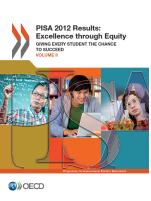PISA 2012 Results: Excellence Through Equity: Giving Every Student the Chance to Succeed (Volume II)
|
This report is the second in a series of volumes presenting the results of PISA's fifth survey (PISA 2012) which was carried out in 65 countries and economies. It defines and measures equity in education and analyses how equity in education has evolved across countries between PISA 2003 and 2012. PISA 2012 assessed the competencies of 15-year-olds in reading, mathematics and science (with a focus on mathematics). Around 510 000 students between the ages of 15 years 3 months and 16 years 2 months participated in the assessment, representing about 28 million 15-year-olds globally.
|
|
Contents |
||
Chapter 1 |
Defining and measuring equity in education |
|
|
This chapter discusses how PISA measures equity in education and identifies some of the groups of students across all PISA-participating countries and economies, who are most at risk when education systems do not give all students the same chances to succeed. |
||
Chapter 2 |
Equity in outcomes |
|
|
This chapter focuses on the relationship between student performance in mathematics and socio-economic status. It examines cross-country differences in this relationship and discusses trends between 2003 and 2012 in equity in education related to socio-economic status, highlighting those countries and economies that have improved both their performance and the level of equity in their education systems. |
||
Chapter 3 |
The challenge of diversity |
|
|
This chapter examines various aspects of students’ and schools’ characteristics that have an impact on education outcomes, including family structure, parents’ job status, school location, immigrant background and language spoken at home. It also discusses trends in immigrant students’ mathematics performance up to 2012. |
||
Chapter 4 |
Equity in opportunities to learn and in resources |
|
|
This chapter explores the concept of equity as it relates to the frequency with which students are exposed to certain mathematics problems in class, teacher quality and quantity, the school’s disciplinary climate, and students’ participation in pre-primary education. It examines the close relationship among these resources, socio-economic status and performance in mathematics. |
||
Chapter 5 |
Policy implications of equity in education |
|
|
This chapter analyses the different measures of equity in education produced by PISA and considers various policy options for improving performance and equity in education outcomes and opportunities for all students. > Download Excel figures Part 1
|
||
Annexes |
Annex A Technical BackgroundAnnex A1 Construction of mathematics scales and indices from the student, school and parent context questionnaires Annex A2 The PISA target population, the PISA samples and the definition of schools Annex A3 Technical notes on analyses in this volume Annex A4 Quality assurance Annex A5 Technical details of trends analyses |
|
Annex B |
PISA 2012 Data
Annex B1 Results for countries and economies |
|
> Back to PISA 2012 Results for Volumes I, III and IV
Related Documents



